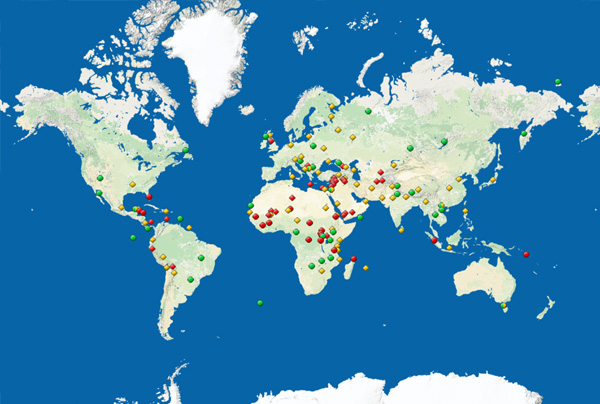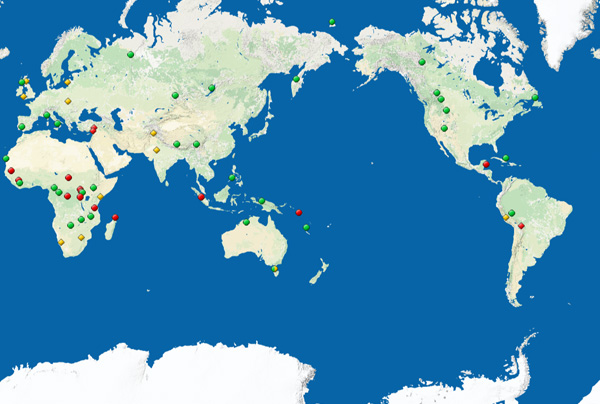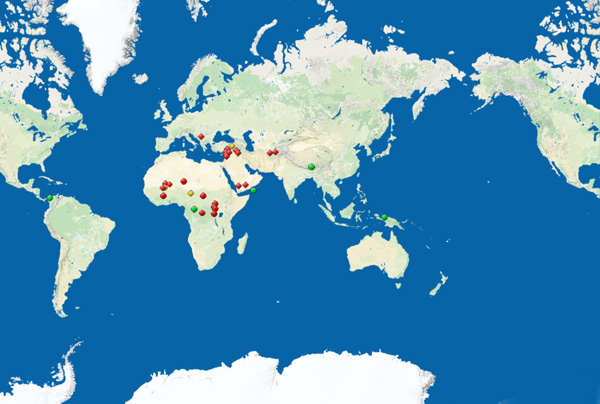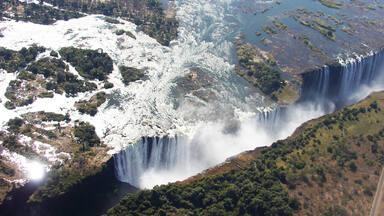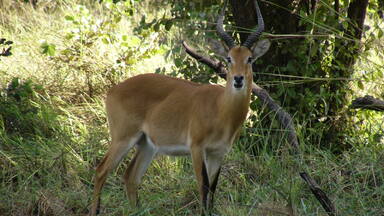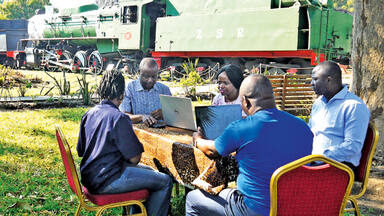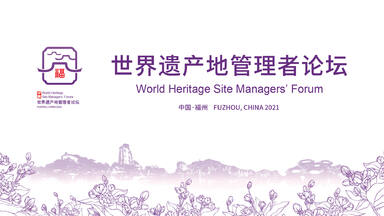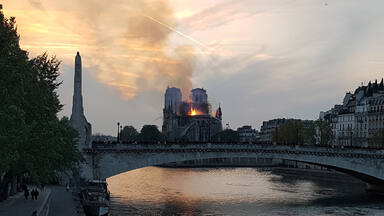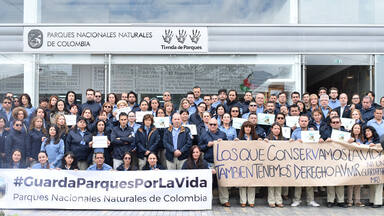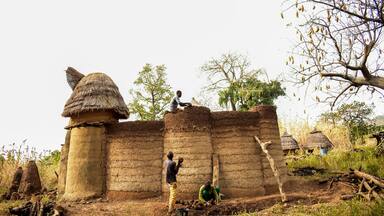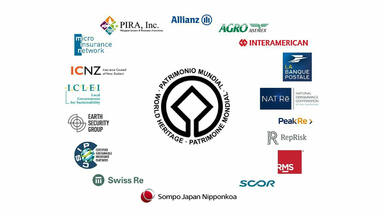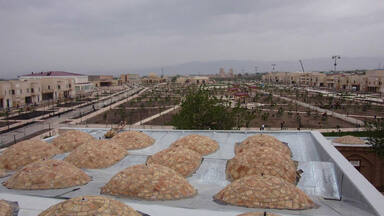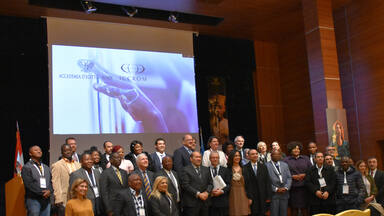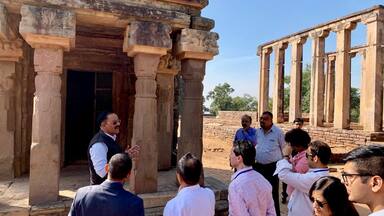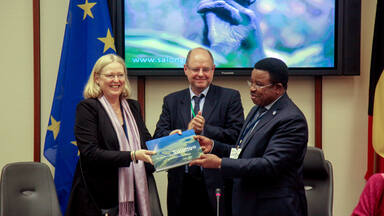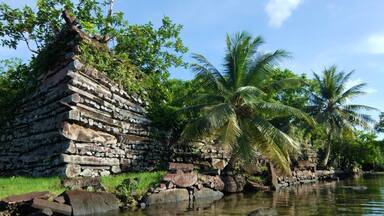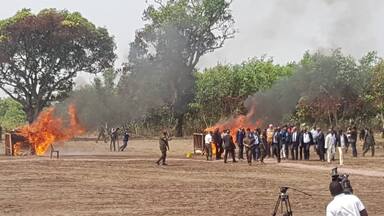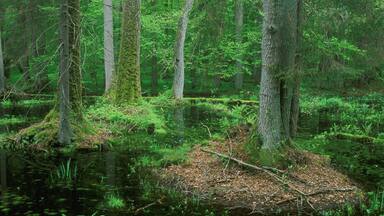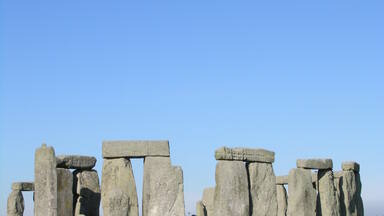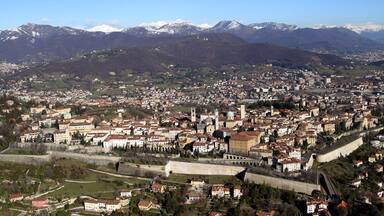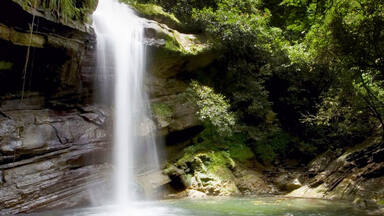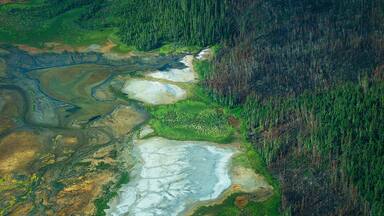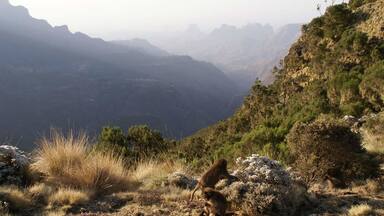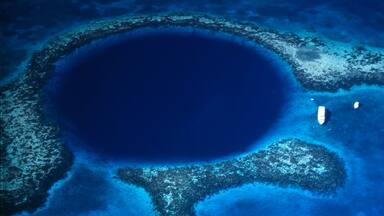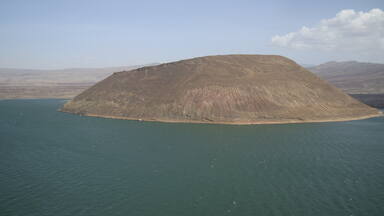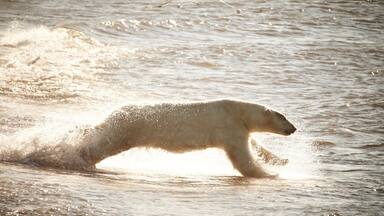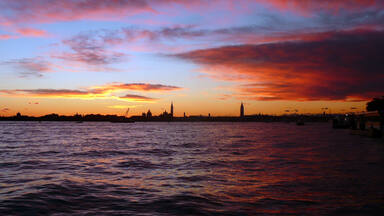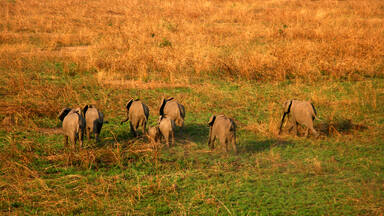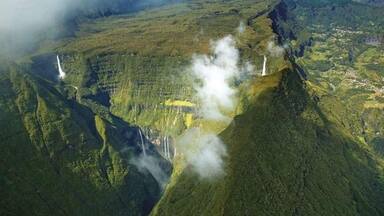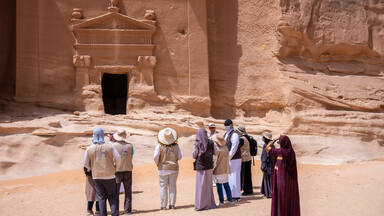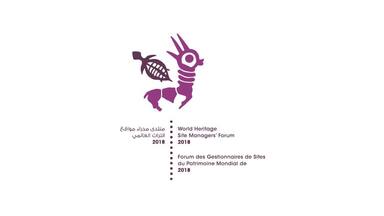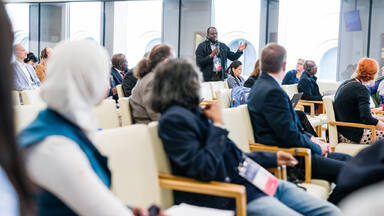Le Système d’information vous offre une mine de données fiables sur l'état de conservation des biens du patrimoine mondial depuis 1979, et sur les menaces auxquelles ils ont été confrontés dans le passé, ou auxquelles ils doivent actuellement faire face. Grace à cet outil, vous avez accès à plusieurs milliers de rapports et décisions adoptées par le Comité du patrimoine mondial dans le cadre de l’un des systèmes de suivi les plus complets de toutes les conventions internationales.
Rechercher et filtrer
Statistiques
Aperçu statistique de la conservation du patrimoine mondial depuis 1979
Biens par année
Répartition des biens examinés depuis 1979, par région
Répartition des biens examinés depuis 1979, par catégorie de patrimoine
Chiffres
Analyse statistique 1979-2013
Analyse des facteurs ayant un impact négatif sur les biens du patrimoine mondial
États parties et région
Recherche par région
Afrique Amérique latine et Caraïbes Asie et Pacifique États arabes Europe et Amérique du NordRecherche par État partie
Afghanistan Afrique du Sud Albanie Algérie Allemagne Andorre Angola Antigua-et-Barbuda Arabie saoudite Argentine Arménie Australie Autriche Azerbaïdjan Bahamas Bahreïn Bangladesh Barbade Bélarus Belgique Belize Bénin Bhoutan Bolivie (État plurinational de) Bosnie-Herzégovine Botswana Brésil Brunéi Darussalam Bulgarie Burkina Faso Burundi Cabo Verde Cambodge Cameroun Canada Chili Chine Chypre Colombie Comores Congo Costa Rica Côte d'Ivoire Croatie Cuba Danemark Djibouti Dominique Égypte El Salvador Émirats arabes unis Équateur Érythrée Espagne Estonie Eswatini (l') État de Palestine États-Unis d'Amérique Éthiopie Fédération de Russie Fidji Finlande France Gabon Gambie Géorgie Ghana Grèce Grenade Guatemala Guinée Guinée équatoriale Guinée-Bissau Guyana Haïti Honduras Hongrie Îles Cook Îles Marshall Îles Salomon Inde Indonésie Iran (République islamique d') Iraq Irlande Islande Israël Italie Jamaïque Japon Jordanie Kazakhstan Kenya Kirghizistan Kiribati Koweït Lesotho Lettonie Liban Libéria Libye Lituanie Luxembourg Macédoine du Nord Madagascar Malaisie Malawi Maldives Mali Malte Maroc Maurice Mauritanie Mexique Micronésie (États fédérés de) Monaco Mongolie Monténégro Mozambique Myanmar Namibie Nauru Népal Nicaragua Niger Nigéria Nioué Norvège Nouvelle-Zélande Oman Ouganda Ouzbékistan Pakistan Palaos Panama Papouasie-Nouvelle-Guinée Paraguay Pays-Bas (Royaume des) Pérou Philippines Pologne Portugal Qatar République arabe syrienne République centrafricaine République de Corée République de Moldova République démocratique du Congo République démocratique populaire lao République dominicaine République populaire démocratique de Corée République-Unie de Tanzanie Roumanie Royaume-Uni de Grande-Bretagne et d'Irlande du Nord Rwanda Saint-Kitts-et-Nevis Saint-Marin Saint-Siège Saint-Vincent-et-les Grenadines Sainte-Lucie Samoa Sao Tomé-et-Principe Sénégal Serbie Seychelles Sierra Leone Singapour Slovaquie Slovénie Somalie Soudan Soudan du Sud Sri Lanka Suède Suisse Suriname Tadjikistan Tchad Tchéquie Thaïlande Timor-Leste Togo Tonga Trinité-et-Tobago Tunisie Türkiye Turkménistan Tuvalu Ukraine Uruguay Vanuatu Venezuela (République bolivarienne du) Viet Nam Yémen Zambie ZimbabweCartes
Visualisation géographique
de la conservation du patrimoine mondial depuis 1979
Processus de suivi réactif
Qu’est-ce que le suivi réactif ?
Le suivi réactif est la soumission par le Secrétariat, d'autres secteurs de l'UNESCO et les Organisations consultatives au Comité du patrimoine mondial, de rapports sur l'état de conservation de certains biens du patrimoine mondial qui sont menacés.
Quels biens font l’objet d’un rapport sur leur état de conservation ?
Les biens qui font l’objet d’un suivi sont choisis parmi ceux inscrits sur la Liste du patrimoine mondial, selon les considérations suivantes...
Comment sont élaborés les rapports sur l’état de conservation ?
Le Centre du patrimoine mondial et les Organisations consultatives examinent toutes les informations dont ils disposent à l’égard des rapports sur l’état de conservation (SOC) devant être examinés par le Comité du patrimoine mondial à sa prochaine session...
Quelles sont les décisions du Comité du patrimoine mondial ?
Consécutivement à l’examen d’un rapport SOC au cours de sa session ordinaire, le Comité du patrimoine mondial adopte une décision, qui pourra prendre l'une des mesures suivantes
Pourquoi certains biens sont-ils également examinés par le Bureau du Comité du patrimoine mondial ?
Depuis les premières années de la Convention du patrimoine mondial (1979) jusqu'en 2002, le Bureau du Comité du patrimoine mondial avait un rôle important dans la coordination des travaux du Comité, jusqu’au point d’examiner tous les rapports sur l'état de conservation des biens...
Ne pas confondre le suivi réactif et l’exercice du Rapport périodique
Les biens du patrimoine mondial font également l’objet de rapports dans le cadre du processus du rapport périodique. En effet...
Menaces
La liste standard des menaces/facteurs qui influent sur la valeur universelle exceptionnelle des biens du patrimoine mondial se compose d'une série de 14 facteurs primaires, englobant chacun un certain nombre de facteurs secondaires.
En savoir plus sur les menaces
Outils utiles et d’orientation
Outils utiles et notes de conseil
Manuels de référence
Cahiers
Quelques Recommandations
/ Politiques / Stratégies et Déclarations utiles
- Recommandation concernant la protection sur le plan national du patrimoine culturel et naturel (1972)
- Politique pour l'intégration d'une perspective de développement durable dans les processus de la Convention du patrimoine mondial (2015)
- Document d’orientation sur les effets du changement climatique sur le patrimoine mondial (2007)
- Stratégie de réduction des risques liés aux catastrophes sur les biens du patrimoine mondial (2007)
- Recommandation concernant le paysage urbain historique, y compris un glossaire de définitions (2011)
- Conseil International des Mines et Métaux (ICMM) - Aires protégées et activités minières ; Déclaration de position (2003)
Formats de rapport
![]()
Format pour la soumission des rapports sur l’état de conservation
par les États parties
Autres outils en ligne utiles
Partenaires
Organisations consultatives du Comité du patrimoine mondial
- ICCROM (Centre international d’études pour la conservation et la restauration des biens culturels)
- ICOMOS (Conseil International des Monuments et des Sites)
- UICN (Union internationale pour la conservation de la nature)
Autres conventions et programmes de l’UNESCO
- Convention pour la protection des biens culturels en cas de conflit armé (1954) et son deuxième Protocole (1999)
- Convention concernant les mesures à prendre pour interdire et empêcher l'importation, l'exportation et le transfert de propriété illicites des biens culturels (1970)
- Comité intergouvernemental pour la promotion du retour de biens culturels à leur pays d’origine ou de leur restitution en cas d’appropriation illégale (1978)
- Convention sur la protection du patrimoine culturel subaquatique (2001)
- Convention pour la sauvegarde du patrimoine culturel immatériel (2003)
- Géoparcs mondiaux UNESCO
- Programme sur l’Homme et la biosphère (MAB)
Autres conventions et accords
- Convention sur la biodiversité biologique (CBD)
- Convention sur le commerce international des espèces de faune et de flore sauvages menacées d'extinction (CITES)
- Convention sur la conservation des espèces migratrices appartenant à la faune sauvage (CMS)
- Traité international sur les ressources phytogénétiques pour l'alimentation et l'agriculture
- Ramsar (Convention sur les zones humides)
- Convention internationale pour la protection des végétaux (CIPV)
- Commission baleinière internationale (IWC)
- Accord sur la conservation des oiseaux d'eau migrateurs d'Afrique-Eurasie (AEWA)
- Convention des Nations Unies pour combattre la désertification (CNUCD)
- Convention-cadre des Nations Unies sur les changements climatiques (CCNUCC)
- Conseil international des mines & des métaux (ICMM) - Mines et aires protégées
Décisions (32)
The World Heritage Committee,
Climate Action for World Heritage
- Having examined Document WHC/23/45.COM/7,
- Recalling Decisions 40 COM 7 and 44 COM 7C adopted at its 40th session (Istanbul/UNESCO, 2016) and at its extended 44th session (Fuzhou/online, 2021),
- Notes that the Panel of experts in relation to Decision 44 COM 7C concerning climate change and World Heritage met by end of March 2022 and made recommendations on the amendments proposed by the Members of the World Heritage Committee and provided a report to the Open-ended Working Group of States Parties to the World Heritage Convention on Climate Change;
- Also notes that the Open-ended Working Group of States Parties to the World Heritage Convention on Climate Change has met seven times to discuss the proposed amendments and the recommendations of the Panel of experts;
- Recognizes Climate Action for World Heritage as an important thematic area of work, thanks the Governments of Australia, Azerbaijan and the Netherlands for their generous financial support and invites States Parties to contribute towards this thematic area to enable the Secretariat to support activities related to the development of the updated Policy Document on Climate Action for World Heritage and its dissemination;
- Recalls again Decision 41 COM 7 in which the Committee ‘reiterate[d] the importance of States Parties undertaking the most ambitious implementation of the Paris Agreement adopted under the United Nations Framework Convention on Climate Change (UNFCCC) by “holding the increase in the global average temperature to well below 2°C above pre-industrial levels and by pursuing efforts to limit the global average temperature increase to 1.5°C above pre-industrial levels, recognizing that this would significantly reduce the risks and impacts of climate change” ’, again strongly urges all States Parties to undertake actions to address Climate Change under the Paris Agreement consistent with their common but differentiated responsibilities and respective capabilities, in the light of different national circumstances, that are fully consistent with their obligations within the World Heritage Convention to protect the Outstanding Universal Value of all World Heritage properties;
Improving the perception of the List of World Heritage in Danger
- Recalling Decision 40 COM 7 adopted at its 40th session (Istanbul/UNESCO, 2016),
- Reaffirming the need to promote a better understanding of the implications and benefits of properties being inscribed on the List of World Heritage in Danger,
- Takes note with appreciation of the thorough study on the perceptions of the List of World Heritage in Danger, together with its recommendations that could form the basis of a communication strategy and thanks the State Party of Norway for its financial support;
- Expresses its gratitude to all the stakeholders of the 1972 World Heritage Convention who have actively contributed to this study;
- Takes note with satisfaction of the recommendations formulated in the study on possible approaches to reverse negative perceptions and to raise the profile of the List of World Heritage in Danger as a positive tool, enhancing understanding and highlighting its importance for the protection of the Outstanding Universal Value of World Heritage properties and requests all stakeholders of the Convention to take them on-board and implement them at their level as soon as possible;
Enhancing dialogue among States Parties, Advisory Bodies and the World Heritage Centre - Recommends that the World Heritage Centre and the Advisory Bodies ensure the following steps regarding the monitoring of state of conservation of the inscribed properties:
- Whenever an expert mission takes place within the framework of the reactive monitoring process, the draft mission report will be shared, prior to its publication, with the concerned State Party to allow them to review the report and to propose corrections on any factual inaccuracies and comment on other critical issues and/or misunderstandings, and consultations will be held, if necessary, between the concerned State Party and relevant Advisory Body/ies;
- Whenever an expert mission takes place within the framework of the reactive monitoring process and the inscription of the concerned property on the List of World Heritage in Danger is recommended in the mission report, consultations will be held between the concerned State Party and relevant Advisory Body/ies, and the State Party’s view will be referred to in the mission report or in its annex in the event that the views of both parties do not converge in the consultations;
- Whenever the inscription of the property on the List of World Heritage in Danger is proposed in a working document on state of conservation produced by the World Heritage Centre and the Advisory Bodies to be examined by the Committee, consultations will be held, within the available deadlines, prior to the distribution of the document, between the concerned State Party, relevant Advisory Body/ies and the World Heritage Centre, and the State Party’s view will be referred to in the working document such as in its annex in the event that the views of the concerned parties do not converge;
- Recommends that States Parties enhance dialogue among themselves regarding properties that are or may be proposed for inscription on the List of World Heritage in Danger, in particular cases in which causes of the danger are transboundary;
- Recommends that the World Heritage Centre and the Advisory Bodies continue to work on knowledge sharing of best practice cases in which the property was removed from the List of World Heritage in Danger, and also encourage them to enhance providing capacity building for the States Parties who have properties on the List of World Heritage in Danger;
- Recommends that the budget of the World Heritage Centre and Advisory Bodies be adjusted in proportion with the additional workload generated by the additional dialogue and consultations as well as for capacity building for States Parties with properties on the List of World Heritage in Danger.
The World Heritage Committee,
- Having examined Document WHC/23/45.COM/7,
- Recalling Decisions 40 COM 7, 41 COM 7, 42 COM 7, 43 COM 7.2, and 44 COM 7.2 adopted at its 40th (Istanbul/UNESCO, 2016), 41st (Krakow, 2017), 42nd (Manama, 2018), 43rd (Baku, 2019) and extended 44th (Fuzhou/online, 2021) sessions respectively,
- Also recalling that all proposed major interventions in and around World Heritage properties should be subject to rigorous impact assessments, as outlined in Paragraph 118bis of the Operational Guidelines, in line with the Guidance and Toolkit for Impact Assessments in a World Heritage Context, and that both the proposals and the impact assessment-related documentation be submitted, in accordance with Paragraph 172 of the Operational Guidelines, to the World Heritage Centre for review by the Advisory Bodies, before any intervention for new construction, demolition, modification, recovery or reconstruction commences or decisions made that cannot be reversed;
Emergency situations resulting from conflicts
- Expresses utmost concern that conflicts (including armed conflict and civil unrest) continue to represent a major threat to World Heritage properties and remain one of the major reasons for the inscription of properties on the List of World Heritage in Danger;
- Regrets the loss of human life and the degradation of humanitarian conditions resulting from the prevailing conflict situations in several countries, including threats to the personnel and local communities, as well as the continuing threats facing cultural and natural heritage in regions of armed conflict where there are significant concerns regarding security in and around World Heritage properties;
- Welcomes protection and conservation efforts being undertaken by the concerned States Parties at World Heritage properties and that the States Parties are progressively proceeding with the development of corrective measures and the definition of the Desired state of conservation for the removal of the properties from the List of World Heritage in Danger (DSOCR) for some cultural properties following due process;
- Urges again all parties associated with conflicts to ensure the protection of cultural and natural heritage, including to avoid their use for military purposes and also urges States Parties to fulfil their obligations under international law, including the 1954 Convention and its two Protocols, by taking all possible measures to protect such heritage, including of World Heritage properties and sites included in Tentative Lists;
- Reiterates its utmost concern about the continuing threats of wildlife poaching and illegal trafficking of wildlife and timber products linked to impacts of armed conflict and organized crime, which is eroding the biodiversity and Outstanding Universal Value of World Heritage properties around the world, and further urges States Parties to take the necessary measures to curb this problem, including through the implementation of the Convention on International Trade in Endangered Species of Wild Fauna and Flora (CITES);
- Also reiterates its utmost concern at the increase in illicit trafficking of cultural objects, resulting from armed conflicts, and appeals to all States Parties to cooperate in the fight against these threats, and for cultural heritage protection in general, including through the ratification of the 1970 Convention and the 1954 Convention and its two Protocols, as well as the implementation of United Nations Security Council Resolutions 2199 (2015), 2253 (2015) and 2347 (2017), and the implementation of the UNESCO Recommendations on Museums and Collections (2015);
- Welcomes the World Heritage Centre and the Advisory Bodies’ continued actions in responding to emergencies and conflicts threatening cultural and natural heritage, including the Outstanding Universal Value, including through the Revive the Spirit of Mosul and the Li Beirut initiatives, the Heritage Emergency Fund (HEF) and the Rapid Response Facility (RRF) and also UNESCO actions in Ukraine and emergency programmes in Sudan, Syria, Yemen, Iraq, Libya, Democratic Republic of the Congo, Benin, Burkina Faso, Niger, Mali, Central African Republic, Palestine, and other countries;
- Reiterates its call upon the international community to further support the safeguarding of the cultural and natural heritage of countries affected by conflict, through earmarked funds or through contributions to the UNESCO World Heritage Fund, HEF and RRF;
Recovery and Reconstruction
- Recalls that reconstruction is justifiable only in exceptional circumstances, and should be based on thorough documentation, guided by conservation plans and policies that support the Outstanding Universal Value (OUV), and as outlined in Paragraph 86 of the Operational Guidelines;
- Takes note of the various programmes initiated and implemented by the World Heritage Centre and the Advisory Bodies and other international partners to respond to the destruction of heritage through documentation, emergency response, recovery and reconstruction;
- Welcomes the continued efforts by States Parties in responding to post-conflict and post-disaster recovery and reconstruction, including the various reconstruction projects nearing completion, as well as their positive social and community interlinkages and thanks France, Germany, Japan, Norway, the Republic of Korea, Spain, the Sultanate of Oman, the United Arab Emirates, the European Union, the International Alliance for the Protection of Heritage in Conflict Areas (ALIPH), the Heritage Emergency Fund and the Arab Regional Centre for World Heritage (ARC-WH) for their generous support, including for the reconstruction of the House of Wonder, an emblematic building in East Africa, in the Stone Town of Zanzibar, United Republic of Tanzania;
- Encourages all State Parties to prepare comprehensive risk preparedness strategies and emergency response plans for World Heritage properties that are exposed to risk from natural disasters;
- Requests States Parties to ensure the integrity of the OUV of World Heritage properties and that all recovery and reconstruction projects be guided by thorough and comprehensive recovery proposals, including plans and drawings, integrated and aligned with the needs of local communities and subject to rigorous impact assessments as noted in Paragraph 3 above;
Kunming-Montreal Global Biodiversity Framework
- Welcomes the adoption of the Kunming-Montreal Global Biodiversity Framework (GBF) during the fifteenth meeting of the Conference of the Parties (COP-15) to the Convention on Biological Diversity (CBD) in December 2022 to set the global pathway to halt and reverse biodiversity loss by 2030, in line with the 2030 Agenda for Sustainable Development;
- Requests the States Parties to fully harness the World Heritage Convention in supporting the goals and targets of the GBF, including through effective collaboration among convention focal points, and by integrating World Heritage-related objectives within their National Biodiversity Strategies and Action Plans (NBSAPs);
- Also requests the World Heritage Centre, in collaboration with the Advisory Bodies, to identify and develop coordinated actions on World Heritage and the GBF, including specific guidance on how the World Heritage Convention might contribute to the aims of the Joint Programme of Work on the Links between Biological and Cultural Diversity, subject to the availability of resources, and to integrate reporting on progress regarding contributions of World Heritage to the GBF under the Committee’s item on Sustainable Development and invites States Parties to contribute financially for this purpose;
Urban pressure
- Notes that pressures on historic urban areas arising from inappropriate urban development interventions and inadequate development controls, rapid and inadequately planned development, including large development projects, additions that are incompatible in their volume, tourism and transportation infrastructure, as well as the accumulated impact of incremental changes, have continued within numerous World Heritage properties and in their buffer zones and settings, and considers that these present significant potential and ascertained major threats to the Outstanding Universal Value of properties, including their integrity and authenticity, and increase their vulnerability to disasters, such as those resulting from climate change;
- Also noting that the findings of the UNESCO Third Member State Consultation on the Implementation of the 2011 Recommendation on the Historic Urban Landscape (2011 Recommendation) request States Parties to implement the 2011 Recommendation in urban World Heritage properties and, with technical assistance from the World Heritage Centre and the Advisory Bodies, to integrate it as a tool in the monitoring processes of the state of conservation, and the preparation and updating of management plans concerning nomination process for World Heritage properties in cities and settlements including with the support of the World Heritage Urban Heritage Atlas tool;
- Recalls the essential contribution of local communities, and the importance of their participation in decision-making processes, as well as the need to support sustainable, compatible, and inclusive livelihoods for local communities and further requests States Parties to embed stakeholder engagement in management systems and processes, in line with Paragraph 12 of the Operational Guidelines, with the 2011 Recommendation and the Policy on the Integration of a Sustainable Development Perspective into the Processes of the World Heritage Convention (2015);
- Invites all States Parties to establish governance mechanisms for urban heritage that support coordination and coherence across different sectors such as infrastructure, tourism, transport, and urban development to integrate heritage management into the plans and processes of the settlement and the region;
- Stresses the importance of carrying out impact assessments to evaluate and thereby avoid or manage potential threats to the OUV of properties, including their authenticity and integrity, arising from new urban development projects in line with paragraph 3 above;
- Also emphasizes the need to enhance resilience of World Heritage properties in urban areas vulnerable to climate change-related impacts, in line with the 2011 Recommendation and the outcomes of the activities of the UNESCO World Heritage Cities Programme;
Infrastructure development - Notes with concern the growing pressure of infrastructure development, such as extractive mining activities, dams, hydropower, transportation infrastructure, and the expansion of tourism infrastructure, on the Outstanding Universal Value of World Heritage properties;
- Welcomes the commitment announced by the International Hydropower Association (IHA) that no new hydropower projects should be developed in World Heritage properties, and a duty of care pledge to implement high standards of performance and transparency for any hydropower projects outside of but affecting protected areas such as World Heritage properties;
- Strongly urges all States Parties, development proponents and financiers to incorporate the Guidance and Toolkit for Impact Assessments in a World Heritage Context into planning and decision-making processes to contribute to safeguarding the OUV of World Heritage properties, in line with Paragraph 3 above;
- Requests all States Parties to:
- Inform the World Heritage Centre of any planned developments located within a World Heritage property, its buffer zone or in its wider setting that may impact on its OUV, prior to making any decision that would be difficult to reverse, in conformity with Paragraph 172 of the Operational Guidelines,
- Ensure that the potential impacts of developments on the OUV are appropriately assessed, in line with Paragraph 3 above,
- Ensure that no proposed developments proceed that would negatively impact on the OUV,
- Ensure that no deliberate measures are taken, which might damage directly or indirectly the inscribed properties situated on the territory of other States Parties to the Convention, in conformity with Article 6 of the World Heritage Convention;
Corporate Sector and the World Heritage ‘no-go’ commitment -
Welcomes the launch of the UNESCO Guidance for the World Heritage ‘No-Go’ Commitment: Global standards for corporate sustainability as a means to assist the corporate sector to develop or update their policies and strategies to safeguard World Heritage, and thanks the Government of Flanders (Belgium) for its financial support;
-
Requests the World Heritage Centre, in collaboration with the Advisory Bodies, to continue its collaboration with the corporate sector in view of supporting the adoption and implementation of World Heritage safeguard policies, and invites companies and relevant organisations to develop and update their corporate sustainability policies in line with the UNESCO guidance, and lodge them with UNESCO;
Rights-based Issues
- Recalling Article 5 of the Convention that each State Party shall adopt for each country a general policy, which aims to give the cultural and natural heritage a function in the life of the community, and the integration of the protection of that heritage into comprehensive planning programmes are means of ensuring effective protection, conservation and presentation of cultural and natural heritage,
- Also recalling the Universal Declaration of Human Rights, the International Covenant on Economic, Social and Cultural Rights, the International Covenant on Civil and Political Rights, and the United Nations Declaration on the Rights of Indigenous Peoples,
- Further recalling the various provisions of the Operational Guidelines that encourage States Parties to adopt a human rights-based approach to the nomination and subsequent effective management of inscribed World Heritage properties,
- Bearing in mind that specific and significant spiritual meanings are mentioned to justify the Outstanding Universal Value of a large number of the World Heritage properties to be found in most countries around the world, also recalling a number of research studies and analyses of religious heritage and sacred sites carried out by the Advisory Bodies,
- Underlining that living religious and sacred sites require specific approach and policies for protection and management that take into account their distinct spiritual nature, crucial to their Outstanding Universal Value, as a key factor in their conservation and that such policies cannot be sustainable without in-depth consultation with the appropriate stakeholders;
- Calls upon all States Parties to ensure that human rights, including cultural rights, are protected as an integral part of the management of World Heritage properties by establishing equitable and participatory governance arrangements;
- Strongly condemns all forms of human rights violations and abuses towards indigenous peoples and local communities (IPLCs), including any forced eviction;
- Notes with utmost concern the reported cases of alleged human rights abuses towards IPLCs in and around World Heritage properties and therefore, strongly urges the States Parties concerned to urgently investigate the allegations and take appropriate actions to address their findings, following an equitably governed consultative process with the participation and decision making of all rightsholders and stakeholders;
- Reminds States Parties of their obligations to ensure that the management of World Heritage properties follows a rights-based approach that includes full involvement of all rightsholders and stakeholders, in particular IPLCs, in line with the 2015 Policy on World Heritage and Sustainable Development, the UNESCO Policy on Engaging with Indigenous Peoples and the 2030 Agenda for Sustainable Development and international human rights standards;
- Requests the Secretariat, with the Advisory Bodies, to enhance activities in the framework of the Initiative on Heritage of Religious Interest and to resume elaboration of the thematic paper proposing to the States Parties general guidance regarding the management of their cultural and natural heritage of religious interest, and in compliance with the national specificities, and invites the States Parties to provide voluntary contributions to this end;
Earth observation and spatial data for World Heritage conservation
- Welcomes the development of the World Heritage Online Mapping Platform to provide a comprehensive, complete, accurate and geo-referenced dataset for the World Heritage properties that, in the pilot phase of the project, are in the Europe and North America region, and thanks the Government of Flanders (Belgium) for the support provided to the pilot phase of the project;
- Also welcomes the Urban Heritage Atlas platform and tool for geo-referenced cultural mapping of the attributes of urban heritage and invites States Parties to use the tool for better managing their World Heritage properties and takes note with satisfaction of the continued activities of the Urban Heritage Climate Observatory applying earth observation tools for World Heritage cities;
- Invites States Parties to contribute to the above-mentioned platforms and tools with already available GIS data, complementary narrative and visual analysis, expertise, networks, and financial resources;
- Reiterates its request to States Parties, the World Heritage Centre and the Advisory Bodies, to strengthen collaborative partnerships with UNESCO Category 2 Centres and other relevant institutions with a view to furthering the necessary institutional and individual capacity needed to make full use of spatial data, Earth observation satellite technologies and analysis tools for the monitoring of the state of conservation of World Heritage properties.
The World Heritage Committee,
- Having examined Document WHC/21/44.COM/7,
- Recalling Decisions 40 COM 7, 41 COM 7, 42 COM 7 and 43 COM 7.1, adopted at its 40th (Istanbul/UNESCO, 2016), 41st (Krakow, 2017), 42nd (Manama, 2018) and 43rd (Baku, 2019) sessions respectively,
Evaluation of the Reactive Monitoring process
- Taking note with appreciation of the recommendations of the evaluation of the Reactive Monitoring process, as prioritized in line with Decision 43 COM 7.1, requests all stakeholders of the Convention to implement them at their level as soon as possible;
- Welcomes the matrix structure developed by the World Heritage Centre in consultation with the Advisory Bodies, which provides a clear framework to report back to the Committee on the implementation of the priority recommendations, and requests them to prepare an Implementation Plan;
- Also requests the World Heritage Centre, in consultation with the Advisory Bodies, and in line with Recommendation 34 of the evaluation, to present a progress report on the implementation of the recommendations, for examination at its 47th session;
Issues related to the List of World Heritage in Danger
- Reaffirming the need to promote a better understanding of the provisions of the World Heritage Convention and in particular of the implications and benefits of properties being inscribed on the List of World Heritage in Danger and the need to underline that removal of a World Heritage property from the List of World Heritage in Danger is a significant ‘success story’,
- Mindful of its Decision 43 COM 8C.3, which recalled that the inscription of a property on the List of World Heritage in Danger aims to marshal international support to help the State Party effectively address the challenges faced by the property by engaging with the World Heritage Centre and the Advisory Bodies to develop a program of corrective measures to achieve the desired state of conservation for the property, as provided for under Paragraph 183 of the Operational Guidelines; and noting that inscription on the List of World Heritage in Danger also alerts the State Party about the international community’s concern on the state of conservation of the property, provides a timely reminder of obligations that arise under the World Heritage Convention, highlights threats to the attributes of a property which contribute to its Outstanding Universal Value (OUV), and, importantly, initiates a process and pathway to address those threats, including the availability of additional funding,
- Also noting that the development of a Desired state of conservation for the removal of a property from the List of World Heritage in Danger (DSOCR) and a programme for corrective measures is a critical part of the procedure for managing and addressing threats to the OUV of properties inscribed on the List of World Heritage in Danger,
- Takes note with appreciation of the information contained in Document WHC/21/44.COM/7 (Part I.B.) and recognizes that the existing monitoring processes are leading over time to a significant improvement in the conservation status of properties inscribed on the List of World Heritage in Danger;
- Also recalling its previous request for States Parties to develop and submit DSOCRs for all properties included in the List of World Heritage in Danger by its 40th session in 2016 at the latest, expresses its concern however that less than half of the properties inscribed on the List of World Heritage in Danger have a DSOCR and therefore strongly urges all States Parties concerned to:
- Use the 2013 Guidance to develop and submit DSOCRs with quantifiable indicators to track progress for all remaining properties as soon as practicable, with a view to having them all in place by its46th session, with the support of the World Heritage Centre and Advisory Bodies;
- Ensure that for any property newly inscribed on the List of World Heritage in Danger, a DSOCR is developed and submitted no later than one year following inscription;
- Acknowledging initial pilot activities to explore possible approaches and methodologies for costed action plans, requests these efforts to continue and calls upon all interested States Parties to support a workshop to develop a common methodology and guidelines for when and how corrective measures might be supported by costed action plans;
- Also strongly urges States Parties, NGOs, private sector and donors to redouble efforts to prioritize attention to those World Heritage properties, which have been on the List of World Heritage in Danger for 10 years or longer;
- Thanks the State Party of Romania for having hosted a multi-stakeholders international workshop in September 2019, providing a unique space for discussions and networking of professionals regarding the preservation of cultural and natural World Heritage facing dangers, including exchange of good practice, and highlighting the benefits of the List of World Heritage in Danger;
- Expresses its gratitude to the State Party of Norway for its generous support for a project that aims to improve the perception of the List of World Heritage in Danger, and also requests the World Heritage Centre to present a progress report on this activity to its 45th session.
The World Heritage Committee,
- Having examined Document WHC/21/44.COM/7,
- Recalling Decisions 40 COM 7, 41 COM 7, 42 COM 7, 43 COM 7.2 and 43 COM 7.3, adopted at its 40th (Istanbul/UNESCO, 2016), 41st (Krakow, 2017), 42nd (Manama, 2018) and 43rd (Baku, 2019) sessions respectively,
Emergency situations resulting from conflicts
- Deplores the loss of human life and the degradation of humanitarian conditions resulting from the prevailing conflict situations in several countries, and continues to express its utmost concern at the devastating damage sustained and the continuing threats facing cultural and natural heritage in regions of armed conflict;
- Urges again all parties associated with conflicts to refrain from any action that would cause further damage to cultural and natural heritage, including their use for military purposes, and also urges States Parties to fulfil their obligations under international law by taking all possible measures to protect such heritage, in particular the safeguarding of World Heritage properties and sites included in Tentative Lists;
- Reiterates its utmost concern about the continuing threats of wildlife poaching and illegal trafficking of wildlife and timber products linked to impacts of armed conflict and organized crime, which is eroding the biodiversity and Outstanding Universal Value (OUV) of many World Heritage properties around the world, and further urges States Parties to take the necessary measures to curb this problem, including through the implementation of the Convention on International Trade in Endangered Species of Wild Fauna and Flora (CITES);
- Also reiterates its utmost concern at the increase in illicit trafficking of cultural objects, resulting from armed conflicts, and appeals to all States Parties to cooperate in the fight against these threats, and for cultural heritage protection in general, including through the ratification of the 1970 Convention and the 1954 Convention and its two Protocols, as well as the implementation of United Nations Security Council Resolutions 2199 (2015), 2253 (2015) and 2347 (2017);
- Reiterates its call upon the international community to further support the safeguarding of the cultural and natural heritage of countries affected by conflict, through earmarked funds or through contributions to the UNESCO Heritage Emergency Fund;
Recovery and Reconstruction
- Welcomes the continued reflection on recovery and reconstruction and the broad dissemination of the Warsaw Recommendation in multiple languages as a basis for further reflections and also welcomes the dedicated webpage established by the World Heritage Centre;
- Expresses its gratitude to the Polish authorities for the organization of the webinar “The invincible city: Society in cultural heritage recovery” in October 2020 and to the Arab Regional Centre for World Heritage (ARC-WH) for the “Conference on heritage reconstruction - its economic, social, and psychological aspects in the process of post-trauma recovery” (Bahrain, March 2021);
- Takes note of the various resources already published and in the process of publication;
- Noting the value of accurate pre-existing documentation in the recovery of built and other heritage following destruction, strongly encourages the States Parties and all other stakeholders of the Convention to stimulate the documentation of heritage structures, including through cutting-edge digital technologies, to create databases of documentation for future reference;
Post-2020 Global Biodiversity Framework
- Notes with utmost concern the results of the Intergovernmental Science-Policy Platform on Biodiversity and Ecosystem Services (IPBES) Global Assessment Report on Biodiversity and Ecosystem Services, which shows that nature is declining globally at rates unprecedented in human history and that no significant progress has been achieved on most of the 20 Aichi Biodiversity Targets, and encourages the Parties of the Convention on Biological Diversity (CBD) to adopt an ambitious post-2020 Global Biodiversity Framework (GBF), which can bring about the transformative change needed to halt the loss in biodiversity;
- Considers that the post-2020 GBF should provide a common framework for all Biodiversity-related Conventions and build on the strengths of each convention, and strongly encourages the Parties of CBD to take into account the recommendations of the expert meeting “Harnessing the power of World Heritage for a better future: World Heritage and the post-2020 Global Biodiversity Framework” in the post-2020 GBF to recognize and better integrate the contribution of the World Heritage Convention to global biodiversity conservation;
- Requests the World Heritage Centre and IUCN to continue to engage with the preparatory process of the post-2020 GBF, in order to advance consideration of the World Heritage Convention;
- Also requests the States Parties to ensure that there is effective liaison between the respective national focal points for the CBD and the World Heritage Convention, to ensure that considerations relevant for the Convention are integrated in the GBF, and that the contributions of natural and cultural World Heritage properties, sites on national Tentative Lists, and other internationally designated sites are fully integrated and supported within National Biodiversity Strategy and Action Plans (NBSAPs);
- Further requests the World Heritage Centre and IUCN to report back at its 46th session, with recommended policies and actions to support the adopted post-2020 GBF be taken into account in the processes of the World Heritage Convention;
- Requests furthermore the World Heritage Centre and the Advisory Bodies to consider how the relevance of these proposals for mixed, cultural landscapes and other relevant cultural World Heritage properties, including those cultural properties that overlap with Key Biodiversity Areas, might contribute to the anticipated Joint Programme of Work on the Links between Biological and Cultural Diversity to ensure further integration of nature and culture in the post-2020 GBF and to help achieve its vision of living in harmony with nature by 2050, and report to its 46th session on the approved Programme and how the World Heritage Convention can contribute to its implementation;
- Takes note of the need for additional funding to be provided to support the achievement of biodiversity goals within World Heritage properties, in order to address their contribution to the GBF, and invites the Conference of the Parties of the CBD, in accordance with its decision XIII/21, to take these resourcing needs into account in formulating strategic guidance for the eight replenishment of the Global Environment Facility (GEF) Trust Fund and other international finance mechanisms to support the GBF, considering all elements provided in Section II.C of Document WHC/21/44.COM/7;
Buffer zones
- Noting that a number of World Heritage properties lack formal buffer zones, in particular those on the List of World Heritage in Danger, reaffirms the increasing importance of effective buffer zones to support the protection and management of Outstanding Universal Value (OUV) and building greater resilience of properties to external threats,
- Recalling Decision 32 COM 7.1 and the 2008 expert workshop on World Heritage and Buffer Zones with its specific recommendations to improve guidance, enhance capacity and refine the Operational Guidelines concerning buffer zones,
- Urges States Parties, with the support of the World Heritage Centre and the Advisory Bodies, to:
- Incorporate well-designed buffer zones based on a holistic understanding of natural as well as human induced factors affecting the property, supported by reinforcing relevant legal, policy, awareness and incentive mechanisms, into new nominations and where appropriate into existing properties to ensure enhanced protection of World Heritage properties,
- Place particular emphasis on strategic environmental assessment and impact assessments for potential projects within buffer zones to avoid, negative impacts on OUV from developments and activities in these zones,
- Develop buffer zone protection and management regimes that optimize the capture and sharing of benefits to communities to support the aspirations of the 2015 Policy for the integration of a Sustainable Development Perspective into the processes of the World Heritage Convention,
- Ensure buffer zones are supported by appropriate protection and management regimes in line with the property’s OUV, that build connectivity with the wider setting in cultural, environmental and landscape terms;
- Encourages the States Parties, the World Heritage Centre and the Advisory Bodies, through extra-budgetary support, to revisit and update the recommendations arising from the 2008 expert workshop to enhance capacity through the development of best practice guidelines for designing, establishing, protecting and managing World Heritage buffer zones;
“No-Go” commitment
- Welcomes the continued efforts of the World Heritage Centre, IUCN and other partners to expand the “No-go” commitment to other extractive companies, the banking and insurance sector, the hydropower industry and other relevant companies, commends ENGIE and bp for subscribing to the commitment, and takes note of the initial commitment of Eni, noting the need to strengthen it in order to meet the requests made in previous Committee decisions;
- Reiterates its request to all relevant private and public sector companies to integrate into their sustainability policies, provisions for ensuring that they are not financing or implementing projects that may negatively impact World Heritage properties and that the companies they are investing in subscribe to the “No-go” commitment, and invites these companies to lodge their adopted policies with the UNESCO World Heritage Centre;
- Also welcomes the global insurance industry Statement of commitment to protect the Outstanding Universal Value of World Heritage properties, developed with the UNEP Finance Initiative Principles for Sustainable Insurance (PSI), also commends the 17 major insurance companies and other supporting institutions of the insurance sector that have so far adhered to the Statement and invites other insurance companies to do so;
- Further welcomes the guidance provided by the International Finance Cooperation (IFC) of the World Bank on Performance Standard 6 on Biodiversity Conservation and Sustainable Management of Living Natural Resources that investment projects in natural and mixed World Heritage properties will not be acceptable for financing, with the possible exception of projects specifically designed to contribute to the conservation of the area;
- Acknowledges with appreciation the financial support of the Government of Flanders (Belgium) for this work and reiterates its request to the World Heritage Centre, in cooperation with the Advisory Bodies, to continue the fruitful dialogue with extractive industries the hydropower industry and other industries, the banking, insurance and investment sector, in line with its Decision 40 COM 7;
Fire: impacts and management
- Acknowledging the extensive damage of fires to natural and cultural World Heritage properties since 2019, and the growing threat of forest and bushfires to certain natural properties and their cultural values, including as a result of climate change impacts,
- Requests States Parties to implement best practice fire management strategies to ensure the protection and management of Outstanding Universal Value (OUV) including, where appropriate, to:
- Prepare site-level fire vulnerability and risk assessments, mitigation, Risk Preparedness, response and recovery plans in the event of potential severe fire impacts on heritage values,
- Incorporate fire research, monitoring of impact, emergency response and mitigation and preparedness measures into management decisions,
- Work with stakeholders to raise awareness on fire risks among communities and build greater capacity to respond and recover following fires,
- Consider customised approaches and strategies that reflect the characteristics and circumstances of naturally and anthropogenically generated fires,
- Explore the potential of new technologies for application in fire managing strategies, including monitoring, and firefighting systems, that will not have negative impact on OUV of the properties,
- Take strong actions to address human-induced climate change in line with global United Nations Framework Convention on Climate Change (UNFCCC) commitments;
Urban pressures on cultural World Heritage properties
- Notes that the pressures on historic urban areas arising from inappropriate or inconsistent development controls, rapid, uncontrolled and planned development, including large development projects, additions that are incompatible in their volume, mass tourism, as well as the accumulated impact of incremental changes have continued within numerous World Heritage properties and in their buffer zones and settings, and considers that these present potential and actual major threats to the Outstanding Universal Value (OUV) of properties, including their integrity and authenticity, as well as increasing their vulnerability to disasters, including those resulting from climate change;
- Also notes the unrelenting pressures of urbanization and urban development in recent years, the essential contribution of local communities, and the consequent need to support sustainable, compatible, and inclusive livelihoods for local communities and embed stakeholder engagement in management systems and processes, with a view to seeking solutions to protecting heritage in the framework of sustainable urban development to counter and manage the impacts of this ever-present threat;
- Notes with appreciation the outcomes of the International Workshop on Historic Urban Contexts in Fukuoka, Japan, in January 2020 (Fukuoka Outcomes) as well as the World Heritage City Lab in June 2020 that proposed several useful recommendations;
- Calls on States Parties to implement the 2011 UNESCO Recommendation on the Historic Urban Landscape (HUL) in World Heritage properties with urban characteristics, in particular, following the methodology and recommendations of the Fukuoka Outcomes and the World Heritage City Lab, and use the opportunity of the 10th anniversary of the HUL Recommendation in 2021 to support key actions to implement the HUL Recommendation also in line with the 2030 Agenda and the New Urban Agenda;
- Stresses the importance of carrying out Heritage Impact Assessments to evaluate and thereby avoid or manage potential threats to the OUV of the property arising from new urban development projects;
- Also emphasizes the need to enhance resilience and recovery of World Heritage properties in urban areas vulnerable to climate change related impacts, in line with the HUL Recommendation and the World Heritage City Lab outcomes, while also enhancing the livability of the properties and their surrounding for their inhabitants;
Heritage Impact Assessments / Environmental Impact Assessments
- Welcomes the new Guidance and Toolkit for Impact Assessment in a World Heritage context through collaboration between the Advisory Bodies and the World Heritage Centre, and thanks the State Party of Norway for supporting this work through the ICCROM-IUCN World Heritage Leadership Programme;
- Requests States Parties to carry out subsequent Environmental Impact Assessment/Heritage Impact Assessment in line with the new guidance;
- Calls upon States Parties and organizations to provide additional funding and support for compiling the guidance on Strategic Environmental Assessment and support other capacity building activities on impact assessments;
Conservation of fabric, skills and traditional and contemporary technologies
- Recognizes that repair after disasters as well as continued maintenance over time of the integrity and authenticity of the fabric that contributes to the Outstanding Universal Value (OUV) of cultural and mixed World Heritage properties require specific and specialist skills-sets and crafts, knowledge sets and systems often based in cultural-specific technologies developed over many generations;
- Notes that the challenges encountered in the maintenance and restoration of the physical fabric of cultural and mixed World Heritage properties often arise from the lack of appropriate knowledge and skills among craftspeople, as well as a lack of appropriate historically developed and utilised materials;
- Encourages the States Parties and all other stakeholders of the Convention to:
- Stimulate existing (and develop new) research programmes on traditional methods, technologies and materials, and encourage (and, where necessary support) the intergenerational transmission of traditional and contemporary restoration and maintenance skills, and also embed these in management systems, thereby supporting viable professions for the maintenance of physical human-made attributes that contribute to the OUV of cultural and mixed World Heritage properties,
- Facilitate the development of innovative bespoke technical approaches that enable the long-term sustainable physical conservation of significant fabric, where traditional practices can no longer address changing circumstance,
- Assist in the global dissemination of traditional knowledge, skills and methods for restoration and maintenance of physical fabric through exchanges, publications, digital and other media to benefit the maintenance and restoration of the physical fabric of cultural and mixed World Heritage properties;
Earth observation for World Heritage conservation
- Recalling that Earth observation satellite technologies, spatial data and analysis tools have tremendously improved over the past decade and that they provide powerful additional means for decision-makers and stakeholders of the Convention to find comprehensive solutions to today’s global challenges for World Heritage properties,
- Takes note with satisfaction that the World Heritage Centre, in collaboration with the Group on Earth Observation (GEO) Secretariat and GEO Greek Office, has recently launched the Urban Heritage Climate Observatory (UHCO) as a GEO Community Activity that applies earth observation tools to understand and document the impacts of climate change on World Heritage cities and invites States Parties to contribute to the UHCO with data, expertise, networks, and financial resources;
- Requests States Parties, the World Heritage Centre, the Advisory Bodies, UNESCO Category 2 Centres and other relevant institutions to continue exploring collaborative partnerships, which apply innovative technological advances in remote sensing to the improved monitoring and protection of World Heritage properties;
- Reiterates its encouragements to States Parties to invest in the necessary institutional and individual capacity needed to make full use of such Earth observation technologies for the early detection of activities potentially harmful to the Outstanding Universal Value of World Heritage properties and to better understand trends and respond appropriately.
The World Heritage Committee,
- Having examined Document WHC/21/44.COM/7C,
- Recalling Decisions 40 COM 7, 41 COM 7, 42 COM 7 and 43 COM 7.2, adopted at its 40th (Istanbul/UNESCO, 2016), 41st (Krakow, 2017), 42nd (Manama, 2018) and 43rd (Baku, 2019) sessions respectively,
- Takes note with satisfaction of the wide range of climate change-related activities undertaken by the World Heritage Centre, in collaboration with the Advisory Bodies;
- Thanks the State Party of the Netherlands for having funded the project to update the 2007 Policy Document on the impacts of Climate Change on World Heritage properties, and expresses its gratitude to all the experts and representatives of States Parties, of the World Heritage Centre and of the Advisory Bodies who contributed to the meetings of the Technical Advisory Group;
- Takes note with appreciation that a wide diversity of stakeholders of the World Heritage Convention (States Parties, site managers, Advisory Bodies, World Heritage Centre and representatives of local communities, indigenous peoples, academics, NGOs and civil society) were able to contribute to the updating process through the online consultation launched by the World Heritage Centre;
- Takes note of the new title proposed for the updated Policy Document to become “Policy Document for Climate Action for World Heritage”;
- Endorses the draft "Policy Document on Climate Action for World Heritage”, as presented in Annex 1 of Document WHC/21/44.COM/7C, and requests the World Heritage Centre, in consultation with the Advisory Bodies, to revise it by incorporating views expressed and amendments submitted during the extended 44th session and, as appropriate, to consult Committee members, especially concerning the following points:
- the fundamental principle of common but differentiated responsibilities and respective capabilities (CBDR-RC), which is one of the basic pillars of United Nations Framework Convention on Climate Change (UNFCCC),
- the alignment of climate change mitigation actions with the CBDR-RC and the Nationally Determined Contributions accepted under the UNFCCC and the Paris Agreement, except on an entirely voluntary basis,
- the need for support and capacity-building assistance, as well as the encouragement of technology transfer and financing from developed to developing countries;
- Recalls Decision 41 COM 7 and reiterates the importance of States Parties undertaking the most ambitious implementation of the Paris Agreement of the UNFCCC, and strongly invites all States Parties to ratify the Paris Agreement at the earliest possible opportunity and to undertake actions to address Climate Change under the Paris Agreement consistent with their common but differentiated responsibilities and respective capabilities, in light of different national circumstances, that are fully consistent with their obligations within the World Heritage Convention to protect the Outstanding Universal Value (OUV) of all World Heritage properties;
- Decides to transmit the draft "Policy Document on Climate Action for World Heritage”, following final revisions, for review and adoption at the 23rd session of the General Assembly of States Parties to the Convention in 2021;
- Also requests the World Heritage Centre, jointly with the Advisory Bodies, once the "Policy Document on Climate Action for World Heritage” is adopted by the General Assembly of the States Parties and within the available resources, to elaborate proposals for specific changes to the Operational Guidelines that would be required to translate the principles of this Policy Document into actual operational procedures, and to develop education and capacity-building initiatives that would be needed to enable wide implementation of this Policy Document, and calls on States Parties to contribute financially to this end;
- Further requests the World Heritage Centre, in parallel with the processes outlined in Paragraph 10, to convene a panel of experts drawn from the ad-hoc Working Group, World Heritage Centre, the Advisory Bodies and other qualified experts in the field of climate science and heritage to meet by March 2022 and also calls on State Parties to contribute financially to this end;
- Requests furthermore the World Heritage Centre, jointly with the Advisory Bodies, and subject to available resources, to consider preparing a Guidance Document to facilitate effective implementation of, and support for, the actions, goals and targets of this Policy Document, which could include indicators and benchmarking tools for measuring and reporting progress towards achieving the World Heritage Climate Action Goals, and further calls on States Parties to support this activity through extrabudgetary funding;
- Encourages the States Parties, the World Heritage Centre and the Advisory Bodies to disseminate widely the "Policy Document on Climate Action for World Heritage”, once adopted, through appropriate means to the World Heritage community and the broader public, including in local languages, and to promote its implementation;
- Recommends that the "Policy Document on Climate Action for World Heritage” be interpreted in the context of the UNFCCC, the Paris Agreement (2015) and the United Nations 2030 Agenda for sustainable development, and in conjunction with the Policy Document for the integration of a sustainable development perspective into the processes of the World Heritage Convention (2015);
- Urges States Parties and all stakeholders of the Convention to urgently integrate climate change mitigation and adaptation actions in risk preparedness policies and action plans, in order to protect the OUV of all World Heritage properties, in line with the "Policy Document on Climate Action for World Heritage”;
- Further recommends that World Heritage-related Category 2 Centres and UNESCO Chairs prioritize issues related to the implementation of the "Policy Document on Climate Action for World Heritage” within their capacity-building and research initiatives;
- Finally requests the World Heritage Centre, in consultation with the Advisory Bodies, to present a progress report on the implementation status of the "Policy Document on Climate Action for World Heritage” at its 48th session, after four years of implementation.
The World Heritage Committee,
- Having examined the state of conservation reports of properties inscribed on the List of World Heritage in Danger (WHC/19/43.COM/7A, WHC/19/43.COM/7A.Add, WHC/19/43.COM/7A.Add.2, WHC/19/43.COM/7A.Add.3 and WHC/19/43.COM/7A.Add.3.Corr),
- Decides to remove the following properties from the List of World Heritage in Danger:
- Chile, Humberstone and Santa Laura Saltpeter Works (Decision 43 COM 7A.49)
- Palestine, Birthplace of Jesus: Church of the Nativity and the Pilgrimage Route, Bethlehem (Decision 43 COM 7A.28)
- Recalls that the inscription of a property on the List of World Heritage in Danger, aims to marshal international support to help the State Party effectively address the challenges faced by the property by engaging with the World Heritage Centre and the Advisory Bodies to develop a program of corrective measures to achieve the Desired state of conservation for the property as provided for under Paragraph 183 of the Operational Guidelines.
The World Heritage Committee,
- Having examined Documents WHC/19/43.COM/7,
- Recalling Decisions 40 COM 7, 41 COM 7, and 42 COM 7, adopted at its 40th (Istanbul/UNESCO, 2016), 41st (Krakow, 2017) and 42nd (Manama, 2018) sessions respectively,
- Thanks the State Party of Azerbaijan, Host Country of the 43rd session of the World Heritage Committee (Baku, 2019), for having organized the third World Heritage Site Managers’ Forum, as a capacity-building exercise aimed at increasing the understanding of the World Heritage decision-making process among site managers, in order to achieve more effective protection of Outstanding Universal Value (OUV), takes note with appreciation of the 2019 World Heritage Site Managers’ Forum Statement and encourages the future Host Countries to continue this initiative in conjunction with the World Heritage Committee session;
Evaluation of the Reactive Monitoring process - Taking note with appreciation of the evaluation of the Reactive Monitoring process launched by the World Heritage Centre, thanks the State Party of Switzerland for its financial support, as well as the experts tasked with this evaluation, for their thorough analysis of this process, instrumental in achieving the objectives of the World Heritage Convention;
- Expresses its gratitude to all the stakeholders of the Convention who have actively contributed to this evaluation;
- Notes that the recommendations formulated in the evaluation refer to improvements of the current practices and do not call for structural changes nor amendments to the statutory documents, and requests all stakeholders of the Convention to take them on-board and implement them at their level as soon as possible;
- Agrees that the World Heritage Centre should prioritize implementation of the high priority recommendations, with an initial focus on those relevant to communication, capacity-building, including for site managers, and finance;
- Also requests the World Heritage Centre to present a progress report on the implementation of the recommendations, for examination by the World Heritage Committee at its 44th session in 2020;
Issues related to the List of World Heritage in Danger - Reaffirming the need to promote a better understanding of the implications and benefits of properties being inscribed on the List of World Heritage in Danger,
- Thanks the State Party of Romania for its initiative to host a multi-stakeholder international workshop focusing on the List of World Heritage in Danger, including exchange of good practice, promotion of the properties inscribed on this List and the conservation needs to improve their state of conservation, such as Costed Action Plans;
- Requests the World Heritage Centre to present a report on this workshop and other initiatives related to the List of World Heritage in Danger at the 44th session in 2020;
Selection of the World Heritage properties to be proposed for discussion - Reaffirming the importance of focusing the debates on those properties and global conservation issues of greatest concern during the World Heritage Committee sessions, and taking into account the results of the evaluation of the Reactive Monitoring process,
- Supports the outcomes of the reflection conducted by the World Heritage Centre and the Advisory Bodies regarding the elaboration of the list of state of conservation reports to be proposed for discussion by the Committee, as well as the current practice allowing Committee members to add to this list the reports they wish to discuss, by providing a written request to the Chairperson of the Committee, through the World Heritage Centre, sufficiently in advance of the session, and indicating the reason why the reports are requested to be opened for discussion;
- Recognizes that the selection of the state of conservation reports to be discussed by the Committee during its sessions should be based on clear and objective criteria, including the level of threat to the property, rather than being based on representativity.
Le Comité du patrimoine mondial,
1. Ayant examiné le document WHC-11/35.COM/INF.7C,
2. Rappelant la décision 32 COM 10 adoptée à sa 32e session (Québec, 2008), la décision 33 COM 14A.2 adoptée à sa 33e session (Séville, 2009), la décision 34 COM 12 adoptée à sa 34e session (Brasilia, 2010) et la Résolution 17 GA 9 adoptée à la 17e Assemblée générale des États parties (UNESCO, 2009),
3. Exprime sa gratitude aux États parties de l'Australie et du Sénégal et au Centre du patrimoine mondial de l'UNESCO pour avoir organisé la réunion d'experts sur les défis globaux de l'état de conservation des biens du patrimoine mondial (Dakar, Sénégal, 13-15 avril 2011) ;
4. Prend acte du rapport soumis par les participants à la réunion d'experts susmentionnée;
5. Invite à verser des contributions sous forme d'expertise et de ressources financières pour aider les États parties à mettre en œuvre les décisions sur l'état de conservation des biens du patrimoine mondial;
6. Réitère le fait que les propositions d'inscription de biens sur la Liste du patrimoine mondial doivent démontrer la valeur universelle exceptionnelle conformément aux critères d'inscription et satisfaire aux conditions requises pour ce qui est de l'intégrité/authenticité, la protection et la gestion, comme indiqué dans les Orientations;
7. Demande au Centre du patrimoine mondial et aux Organisations consultatives de développer des recommandations pour examen à la 36e session du Comité du patrimoine mondial, afin de clarifier:
a) les usages, limites et exigences de documentation pour la gestion traditionnelle (paragraphe 108 et suivants),
b) la nécessité d'évaluations d'impact environnemental/évaluations d'impact patrimonial de l'impact de développements potentiels sur la valeur universelle exceptionnelle, l'éventail des activités proposées avec un impact probable sur la valeur universelle exceptionnelle, ainsi que l'envoi de toute la documentation requise par le Centre du patrimoine mondial (paragraphe 172), et
c) les zones tampons ou autres mécanismes de protection, en prenant note des recommandations contenues dans le document WHC-08/32.COM/7.1;
8. Demande de traiter les aspects concernant les partenariats après l'examen du rapport de l'auditeur externe sur PACTe, lors de la 18e Assemblée générale des États parties à la Convention;
9. Demande au Centre du patrimoine mondial et aux Organisations consultatives de définir des options en vue de renforcer et améliorer le processus de rapport sur l'état de conservation des biens, en particulier par un dialogue plus poussé avec les États parties sur les biens du patrimoine mondial confrontés à des difficultés;
10. Demande au Centre du patrimoine mondial d'informer officiellement les États parties des rapports sur l'état de conservation des biens du patrimoine mondial situés sur leur territoire, qui seront examinés par le Comité à la session indiquée;
11. Demande également au Centre du patrimoine mondial d'évoquer à la 36e session du Comité du patrimoine mondial les moyens possibles d'encourager la reconnaissance par les Nations Unies de la protection des biens du patrimoine mondial dans les zones de conflit et de post-conflit à travers l'utilisation de bérets bleus/verts ou d'autres insignes appropriés, et rappelle aux États parties d'inclure les éléments d'information sur les dispositions concernant la réduction des risques de catastrophe/planification d'urgence dans leurs dossiers de proposition d'inscription et leurs plans de gestion;
12. Demande en outre au Centre du patrimoine mondial, en collaboration avec les Organisations consultatives, de préparer en plus de la présentation de l'état de conservation des biens individuels, un rapport thématique sur les principaux facteurs globaux et régionaux ayant des effets préjudiciables sur la valeur universelle exceptionnelle des biens, regroupées selon les cinq catégories de facteurs qui affectent la valeur universelle exceptionnelle identifiées dans le questionnaire du Rapport périodique, Section II, pour avoir l'assurance d'une plus grande cohérence dans la prise de décision sur des biens individuels ;
13. Demande aux Organisations consultatives et au Centre du patrimoine mondial de fournir dans les rapports sur l'état de conservation des biens individuels, un lien vers une base de données intégrée en ligne compilant tous les renseignements pertinents concernant le bien (précédents rapports d'état de conservation et décisions du Comité, état de conservation souhaité, mesures correctives, demandes d'Assistance internationale, etc.) nécessaires à une prise de décision bien informée, devant être hébergée sur le site Web du Centre du patrimoine mondial;
14. Demande également aux Organisations consultatives de développer une base de données des directives existantes sur les facteurs clés ayant un impact négatif sur la valeur universelle exceptionnelle des biens du patrimoine mondial et des outils pour de bonnes pratiques de gestion;
15. Rappelant qu'être signataire de la Convention du patrimoine mondial comporte certaines responsabilités, notamment l'obligation de suivre les Orientations, la gestion des biens du patrimoine mondial selon les normes internationales les plus rigoureuses, la promotion d'une bonne gouvernance et l'allocation de fonds suffisants pour assurer la protection des biens du patrimoine mondial, encourage les États parties à:
a) élaborer des cadres législatifs pour assurer la conformité avec les Orientations et mettre en place un cadre de collaboration entre organismes pour la conservation des biens, y compris ceux qui sont chargés du suivi d'autres conventions et accords internationaux,
b) les sources d'aide et de soutien au-delà de ce qui est disponible dans le cadre du Fonds du patrimoine mondial de l'UNESCO, en notant que les outils, les méthodes et les conseils sont disponibles à la fois au niveau national et international auprès des Organisations consultatives et du Centre du patrimoine mondial et une aide complémentaire doit être sollicitée auprès d'autres donateurs, ONG et organisations internationales,
c) être proactif en matière de développement et de conservation des biens du patrimoine mondial en procédant à une étude d'impact environnemental stratégique (EIES) au moment de la proposition d'inscription afin d'anticiper l'impact de tout développement potentiel sur la valeur universelle exceptionnelle,
d) apporter l'assurance que les EIE/EIP sont effectuées pour des projets de développement qui pourraient affecter les biens et que ces études précisent l'impact sur la valeur universelle exceptionnelle des biens,
e) impliquer les peuples autochtones et les communautés locales dans la prise de décision, le suivi et l'évaluation de l'état de conservation des biens et leur valeur universelle exceptionnelle et lier les bénéfices directs pour la communauté aux résultats de la protection,
f) respecter les droits des peuples autochtones dans la préparation des propositions d'inscription, la gestion et la rédaction des rapports sur les sites du patrimoine mondial dans les territoires des populations autochtones;
g) instaurer et promouvoir une coopération horizontale et une compréhension entre les diverses institutions ayant un impact sur le patrimoine culturel et naturel, y compris les instances gouvernementales chargées de la mise en œuvre des programmes de l'UNESCO sur le plan national, de l'économie, des finances, du développement/planification sur le plan régional, du tourisme, de l'aide sociale, ainsi que les autorités locales,
h) suivre la recommandation concernant la protection, au niveau national, du patrimoine culturel et naturel, adoptée simultanément avec la Convention du patrimoine mondial, par la Conférence générale de l'UNESCO le 16 novembre 1972.
En savoir plus sur la décisionLe Comité du patrimoine mondial,
1. Ayant examiné le document WHC-10/34.COM/7C,
2. Rappelant les décisions 32 COM 7B.129 et 33 COM 7C, adoptées à ses 32e (Québec, 2008) et 33e (Séville, 2009) sessions respectivement,
3. Accueille avec satisfaction le résumé analytique sur les tendances, l'évolution et les menaces relatives à l'État de conservation des biens du patrimoine mondial lors de ces cinq dernières années (2005-2009), comme base d'une réflexion plus approfondie et d'une analyse plus étendue de ces données ;
4. Considère que ce travail souligne la nécessité d'un suivi plus systématique des menaces et de la manière d'identifier et de réagir aux tendances émergentes ;
5. Suggère que les données sur les nouvelles tendances et sur les raisons sous-tendant ces nouvelles tendances pourraient être utiles aux États parties, au Centre du patrimoine mondial et aux Organisations consultatives ;
6. Note que la disponibilité et l'application de l'imagerie satellitaire et autres techniques de télédétection sont en amélioration constante et note que ces techniques peuvent apporter des éléments d'information au fil du temps pour déterminer si de tels impacts sur les valeurs du patrimoine mondial continuent de se produire ou sont pris en compte;
7. Demande que les Organisations consultatives, et en particulier l'UICN, travaillent avec le Centre du patrimoine mondial, le Secteur des Sciences de l'UNESCO et les agences de télédétection concernées, afin d'examiner la faisabilité de l'utilisation de la télédétection pour aider à évaluer la contribution potentielle qu'elle pourrait apporter au suivi de certaines menaces sur la valeur universelle exceptionnelle des biens;
8. Étant donné le pourcentage de menaces liées aux projets de développement et infrastructure et aux constructions de grande hauteur, souligne la nécessité d'évaluations d'impact structurées sur le patrimoine pour les grands projets devant être réalisées dès que l'occasion se présente afin d'évaluer l'impact des projets potentiels sur la valeur universelle exceptionnelle des biens du patrimoine mondial ;
9. Rappelle les dispositions du paragraphe 172 des Orientations et que des informations précoces sur les projets de développement potentiels et l'examen de leurs impacts sur la valeur universelle exceptionnelle sont un outil clé pour garantir la conservation efficace des biens du patrimoine mondial et la crédibilité de la Convention ;
10. Prenant en compte les informations communiquées dans l'introduction du document WHC-10/34.COM/7B et en particulier l'impact des catastrophes naturelles affectant les biens du patrimoine mondial, note les progrès accomplis dans la mise en œuvre de la Stratégie de réduction des risques liés aux catastrophes sur les sites du patrimoine mondial comme indiqué dans le document WHC.10/34.COM/7.3, ainsi que le manuel de référence dernièrement publié sur ce sujet ;
11. Note également que le Centre du patrimoine mondial et les Organisations consultatives ont examiné les approches en matière de sélection des biens pour les rapports sur l'État de conservation et les processus de préparation des Déclarations d'État de conservation souhaité en vue du retrait des biens de la Liste du patrimoine mondial en péril et note par ailleurs que ceux-ci feront l'objet d'un autre examen lors de la prochaine réunion Centre du patrimoine mondial/Organisations consultatives en septembre 2010 ;
12. Reconnaît l'ajout de liens vers des matériels d'illustration dans les rapports sur l'État de conservation qui fournissent des informations sur un potentiel impact visuel sur la valeur universelle exceptionnelle d'un bien et encourage les États parties à partager leurs expériences en matière d'études et simulations d'impact visuel en faisant part au Centre du patrimoine mondial de liens vers des données pertinentes afin de les rendre consultables en ligne ;
13. Demande au Centre du patrimoine mondial et aux Organisations consultatives de présenter un rapport sur les critères, seuils et processus pertinents pour initier les rapports sur l'État de conservation, la faisabilité d'une meilleure utilisation de la télédétection ainsi que sur la préparation et l´examen des Déclarations d'État de conservation souhaité en vue du retrait des biens de la Liste du patrimoine mondial en péril, pour examen par le Comité du patrimoine mondial à sa 35e session en 2011.
En savoir plus sur la décisionLe Comité du patrimoine mondial,
1. Ayant examiné les documents WHC-09/33.COM/7B et WHC-09/33.COM/7B.Add,
2. Rappelant la décision 32 COM 7B.129, adoptée à sa 32e session (Québec, 2008),
3. Prend note du processus suivi pour consulter les États parties afin de garantir l'exactitude des rapports d'état de conservation durant leur élaboration, tel que présenté dans l'introduction du document WHC-09/33.COM/7B, et demande au Centre du patrimoine mondial de faire tout son possible pour s'assurer que la contribution des États parties figure dans ces rapports avant qu'ils soient diffusés ;
4. Reconnaît les efforts d'inclusion des références dans les documents de travail sur l'état de conservation des sites dans la galerie d'images des pages Web du Centre du patrimoine mondial et engage les États parties à fournir dès que possible au Centre du patrimoine mondial le matériel d'illustration électronique vérifié ;
5. Considère que sa demande, dans la décision 32 COM 7B.129, sur l'ajout d'un lien vers le matériel d'illustration vise aussi à donner des informations de référence sur des cas d'impact visuel potentiel sur la valeur universelle exceptionnelle d'un bien et à tenir à la disposition des membres du Comité du patrimoine mondial les simulations d'impact visuel présentées par les États parties ;
6. Encourage les États parties à présenter en ligne des illustrations des projets proposés dans leurs rapports d'état de conservation et de les tenir à la disposition des membres du Comité du patrimoine mondial ;
7. Reconnaissant le nombre croissant de rapports d'état de conservation et le fait que leur examen est un instrument clé pour la conservation efficace et la crédibilité des biens du patrimoine mondial,
8. Notant les résultats du document analytique sur les tendances joint à la Lettre circulaire CL/WHC-09/03 et la discussion de fond qui a eu lieu lors de la 32e session du Comité du patrimoine mondial ;
9. Notant aussi le nombre croissant de catastrophes naturelles qui affectent des biens du patrimoine mondial, demande au Centre du patrimoine mondial et aux Organisations consultatives de préparer un rapport d'avancement de la mise en oeuvre de la Stratégie pour la réduction des risques de catastrophe sur les sites du patrimoine mondial et de le soumettre à l'examen du Comité à sa 34e session en 2010 ;
10. Estime également souhaitable de recevoir du CPM un cadre méthodologique pour savoir comment :
a) Entreprendre l'examen d'un bien dans les rapports d'état de conservation,
b) Demander à un État partie de soumettre un rapport d'avancement ou d'état de conservation dans un délai imparti, et
c) Évaluer les déclarations d'état de conservation souhaité soumises par les États parties;
11. Demande au Centre du patrimoine mondial de :
a) Préparer, en coopération avec les Organisations consultatives, les informations sur les critères, les seuils et les processus qui s'appliquent à l'initiation des rapports d'état de conservation et à l'examen des déclarations d'état de conservation souhaité, pour discussion à la 34e session du Comité du patrimoine mondial en 2010;
b) Préparer également, en concertation avec la Présidente du Comité du patrimoine mondial, un résumé des tendances, des changements et des menaces basé sur un résumé analytique de l'état de conservation des biens du patrimoine mondial sur cinq ans, pour discussion à la 34e session du Comité du patrimoine mondial en 2010, en vue de faire des recommandations permettant d'établir une échelle des priorités dans les efforts de gestion qui s'inscrivent dans la Stratégie globale ;
12. Demande en outre au Centre du patrimoine mondial et aux Organisations consultatives, lors de la préparation des rapports d'état de conservation, d'établir une distinction entre les éléments qui ont un impact ou sont susceptibles d'avoir un impact sur la valeur universelle exceptionnelle d'un site et ceux qui risquent de porter atteinte à des valeurs qui ne sont pas reconnues pour leur caractère universel et exceptionnel ;
13. Note que toutes les missions de suivi réactif proposées dans les projets de décision sur l'état de conservation des biens figurant sur la Liste du patrimoine mondial et la Liste du patrimoine mondial en péril semblent être présentement des missions conjointes du Centre du patrimoine mondial et d'au moins une Organisation consultative, et considère que cela risque d'accroître l'ensemble des exigences budgétaires pour les missions et les ressources humaines ;
14. Demande au Centre du patrimoine mondial d'introduire une section sur les missions proposées dans les rapports d'état de conservation concernés, qui expose les objectifs d'une mission proposée ainsi que les rôles et les tâches spécifiques de toutes les parties prenantes ;
15. Prend également note de la Pétition sur le rôle du noir de carbone dans la mise en péril des biens du patrimoine mondial et encourage tous les États parties à échanger des informations sur les politiques nationales, les réglementations et les possibilités qui existent pour entamer une action volontaire immédiate en vue de contrôler la production de noir de carbone pouvant affecter des biens du patrimoine mondial ;
16. Demande également au Centre du patrimoine mondial et aux Organisations consultatives d'adopter une approche cohérente pour rendre compte de l'impact de l'évolution du climat sur les biens du patrimoine mondial et de veiller à ce que les futures décisions dans ce domaine se basent sur la stratégie du Comité pour aider les États parties à mettre en oeuvre les mesures de gestion qui s'imposent face aux changements climatiques;
17. Notant par ailleurs la profusion des termes employés pour décrire les relations fonctionnelles et spatiales entre les biens du patrimoine mondial, leurs zones tampons et les secteurs alentour, demande au Centre du patrimoine mondial et aux Organisations consultatives de créer un glossaire de termes ainsi qu'une proposition de révisions des orientations concernant les zones tampons, compte tenu des résultats du Groupe d'experts sur cette à cet effet, pour examen par le Comité du patrimoine mondial à sa 34e session en 2010 ;
18. Encourage aussi tous les États parties à mettre pleinement en application le paragraphe 172 des Orientations en informant le Centre du patrimoine mondial des restaurations, des constructions et autres projets susceptibles d'affecter la valeur universelle exceptionnelle d'un bien situé sur leur territoire.
En savoir plus sur la décisionLe Comité du patrimoine mondial,
1. Ayant examiné les documents WHC-08/32.COM/7B, WHC-08/32.COM/7B.Add et WHC-08/32.COM/7B.Add2,
2. Reconnaissant que les rapports sur l'état de conservation sont un instrument important pour soutenir les biens du patrimoine mondial et,
3. Notant la discussion qui a eu lieu à la 32e session du Comité du patrimoine mondial,
4. Demande au Centre du patrimoine mondial de :
a) Préparer, après consultation du Président du Comité du patrimoine mondial, un résumé analytique sur l'état de conservation des biens du patrimoine mondial examinés à la 32e session (Québec, 2008) définissant les tendances, d'ici le 1er novembre 2008, pour diffusion aux membres du Comité et discussion à la 33e session en 2009 ;
b) Identifier les questions émanant du résumé analytique, en concertation avec les Organisations consultatives, à discuter sous les points correspondants de l'ordre du jour du Comité, y compris le mécanisme de suivi renforcé ;
c) Préparer un lexique des termes et des recommandations pour leur application cohérente dans les rapports d'état de conservation ;
d) Fournir pour les biens inscrits sur la Liste du patrimoine mondial en péril et ceux discutés pour inscription sur la Liste du patrimoine mondial en péril, une copie imprimée de la Déclaration de valeur universelle exceptionnelle; lorsque celle-ci est disponible ;
e) Ajouter un lien vers le matériel d'illustration et aux déclarations pertinentes sur la valeur universelle exceptionnelle, et communiquer les informations sur la source et la date ;
5. Demande également au Centre du patrimoine mondial d'identifier un mécanisme pour consultation avec les États parties au cours du développement des Rapports sur l'état de conservation pour garantir leur précision.
En savoir plus sur la décisionLe Comité du patrimoine mondial,
- Ayant examiné les documents WHC-07/31.COM/7A, WHC-07/31.COM/7A.Add, WHC-07/31.COM/7A.Add.2, WHC-07/31.COM/7B, WHC-07/31.COM/7B.Add and WHC-07/31.COM/7B.Add.2,
- Rappelant les décisions 27 COM 7B.106 et 29 COM 7C, adoptées respectivement à ses 27e (UNESCO, 2003) et 29e (Durban, 2005) sessions
- Invite les États parties à suivre le format suivant pour la soumission de leur(s) rapport(s) sur l’état de conservation des biens du patrimoine mondial au Centre du patrimoine mondial :
Format pour la préparation d’un rapport sur l’état de conservation des biens du patrimoine mondial par l’Etat partie
(élaboré à la suite de la réunion entre les Organisations consultatives et le Centre du patrimoine mondial du 25-26 janvier 2007)
Nom du bien du patrimoine mondial (Etat partie) (Numéro d’identification)
1. Réponse de l’État partie à la décision du Comité du patrimoine mondial, paragraphe par paragraphe
[Note: cette information doit faire référence aux développements ayant eu lieu au cours de l’année écoulée, ou depuis la dernière décision du Comité sur ce bien]
ou
1. Dans le cas où le bien est inscrit sur la Liste du patrimoine mondial en péril :
a) Mesures correctives prises par l’État partie en réponse aux décisions du Comité du patrimoine mondial
b) Progrès effectué vers le retrait du bien de la Liste du patrimoine mondial en péril
c) Si besoin est, merci de décrire les succès ou les difficultés rencontrées pour la mise en œuvre des mesures correctives identifiées
[Note: merci de bien vouloir fournir des informations factuelles, d’inclure les dates exactes, les données, etc… et de fournir des commentaires séparément]
d) Le calendrier pour la mise en œuvre des mesures correctives est-il approprié? Si non, merci de proposer une alternative, en la justifiant.
Dans tous les cas :
2. Autres problèmes de conservation actuels identifiés par l’Etat partie
[Note: les problèmes de conservation qui ne sont pas mentionnés dans les décisions du Comité du patrimoine mondial ou toute autre demande d’information de la part du Centre du patrimoine mondial]
3. Conformément au paragraphe 172 des Orientations, merci de décrire toute restauration importante, altération et/ou toute nouvelle construction à l’intérieur de la zone protégée (zone centrale, zone tampon et/ou corridors) qui pourrai(en)t être entreprise(s).
En savoir plus sur la décision
Le Comité du patrimoine mondial,
1. Approuve l'initiative des États parties d'organiser des concours d'architecture pour des nouveaux bâtiments sur des sites du patrimoine mondial, sous réserve de leur compatibilité avec la valeur universelle exceptionnelle desdits sites - y compris dans des environnements historiques, dans l'esprit du Mémorandum de Vienne sur le «Patrimoine mondial et l'architecture contemporaine, Gestion du paysage urbain historique» (mai 2005);
2. Encourage les États parties, lors de la préparation des documents des concours, à informer le Secrétariat, à demander l'avis des Organisations consultatives et à informer le Comité, conformément au paragraphe 172 des Orientations.
En savoir plus sur la décisionLe Comité du patrimoine mondial,
1. Ayant examiné le document WHC-05/29.COM/7B.Rev,
2. Rappelant la décision 7 EXT.COM 4B.1 adoptée lors de sa 7e session extraordinaire (UNESCO, 2004), qui invitait le Directeur du Centre du patrimoine mondial, en consultation avec les Organisations consultatives, à soumettre lors de sa 29e session des propositions sur les voies et moyens d’optimiser les relations entre les résultats du cycle de rapport périodique et les conclusions tirées des rapports sur l’état de conservation – en particulier afin d’assurer la cohérence et une meilleure conservation des sites,
3. Note que des discussions ont eu lieu entre les Organisations consultatives et le Centre du patrimoine mondial (février 2005) et au cours d’un atelier sur l’efficacité de la gestion et sur le suivi de la valeur du patrimoine mondiale des biens du patrimoine mondial (projet « Mise en valeur de notre patrimoine », mai 2005) ;
4. Souligne les différences fondamentales entre les deux processus des rapports périodiques et du suivi réactif comme indiqué dans les Orientations de la Convention (2005) ;
5. Demande la création de meilleures liaisons entre ces deux processus à l’avenir, par exemple par les mécanismes suivants :
a) Les Organisations consultatives et le Centre du patrimoine mondial doivent soigneusement étudier les informations fournies dans les rapports périodiques correspondant aux États parties concernés lorsqu’ils préparent des rapports sur l’état de conservation, et utiliser en particulier les informations fournies sur les menaces qui pèsent sur les biens, pour attirer l’attention sur le suivi réactif ;
b) Les États parties doivent tenir compte du contenu et des décisions des précédents rapports sur l’état de conservation lorsqu’ils préparent leurs rapports périodiques sur des sites précis ; et notamment communiquer les informations les plus récentes sur les menaces signalées par le processus de suivi réactif et sur les mesures prises par l’État partie pour atténuer ces menaces ; et
c) Une base de données en cours d’établissement par le Centre du patrimoine mondial sur les biens du patrimoine mondial devrait permettre de créer des renvois entre les rapports sur l’état de conservation et les rapports périodiques pour améliorer la cohérence entre les mécanismes d’établissement de rapports et assurer, si nécessaire, la prise de mesures de suivi ;
6. Demande au Centre du patrimoine mondial et aux Organisations consultatives d’examiner cette question lors des prochaines réunions avant et pendant l’ « année de réflexion » du processus d’établissement de rapports périodiques.
En savoir plus sur la décisionLe Comité du patrimoine mondial,
1. Ayant examiné les documents WHC-05/29.COM/7A et WHC-05/29.COM/7B.Rev,2. Souhaitant motiver et aider les États parties à obtenir le retrait de biens de la Liste du patrimoine mondial en péril,
3. Encourageant une plus grande coopération internationale entre les États parties en vue de réduire le nombre de biens sur la Liste du patrimoine mondial en péril,
4. Souhaitant améliorer la cohérence et l'efficacité des rapports sur l'état de conservation, en ce qui concerne les biens sur la Liste du patrimoine mondial aussi bien que sur la Liste du patrimoine mondial en péril,
5. Souligne de nouveau que les rapports des missions envoyées pour étudier l'état de conservation de biens figurant sur la Liste du patrimoine mondial, selon le paragraphe 173 des Orientations, doivent comporter :
a) une indication des menaces ou d'une amélioration importante de la conservation du bien depuis le dernier rapport au Comité du patrimoine mondial ;
b) toute suite apportée à de précédentes décisions du Comité du patrimoine mondial concernant l'état de conservation du bien ;
c) des informations sur toute menace ou dommage ou perte de la valeur universelle exceptionnelle, de l'intégrité et/ou de l'authenticité qui avait justifié l'inscription du bien sur la Liste du patrimoine mondial ;
6. Insiste sur le fait que lorsque des mesures complémentaires sont nécessaires, il faut fixer des repères clairs pour indiquer les mesures nécessaires à prendre en vue d'une amélioration notable de la conservation, ainsi que les délais nécessaires pour que ces repères soient atteints ;
7. Demande l'entière coopération des États parties, des Organisations consultatives et du Centre du patrimoine mondial lors du processus de soumission de rapports sur l'état de conservation ;
8. Demande en outre qu'en plus des informations sur les montants de l'assistance internationale du Fonds du patrimoine mondial reçus par un bien, un rapport sur l'état de conservation mentionne également le montant des fonds extrabudgétaires reçus ou nécessaires ;
9. Décide de discuter à sa 30e session (Vilnius, 2006) la possibilité de différer la décision d'inscrire sur la Liste du patrimoine mondial de nouveaux biens d'un État partie qui ne soumet pas les rapports complets demandés par le Comité lors de deux sessions ordinaires consécutives dudit Comité;
10. Décide, en ce qui concerne les biens sur la Liste du patrimoine mondial en péril, conformément à la section IV.B des Orientations de la Convention (2005) :
a) d'identifier clairement les menaces et dangers justifiant l'inscription d'un bien sur la Liste du patrimoine mondial en péril, ainsi que leur degré de gravité ;
b) d'établir, lors de l'inscription sur la Liste du patrimoine mondial en péril, des repères clairs indiquant les mesures à prendre pour traiter les dangers avérés et potentiels;
c) de fixer les délais dans lesquels il faudra atteindre les repères pour pouvoir retirer un bien de la Liste du patrimoine mondial en péril ;
d) de demander au Centre du patrimoine mondial et aux Organisations consultatives, concernant les sites figurant déjà sur la Liste du patrimoine mondial en péril et pour lesquels il n'avait été fixé aucun repère lors de l'inscription, d'inclure dans les futurs rapports concernant ces sites des repères indiquant les mesures correctives à prendre pour traiter les dangers avérés et potentiels, ainsi que des délais;
e) de demander aux Organisations consultatives d'évaluer, sur demande de l'État partie ou du Comité, l'impact des dangers avérés et potentiels sur la valeur universelle exceptionnelle des biens du patrimoine mondial, conformément à la déclaration de valeur universelle exceptionnelle mentionnée au paragraphe 155 des Orientations de la Convention (2005) ; et
f) de demander aux États parties de soumettre un rapport annuel sur l'avancement réalisé par rapport aux repères dans les délais impartis en ce qui concerne leurs biens sur la Liste du patrimoine mondial en péril;
11. Décide également, en ce qui concerne les biens sur la Liste du patrimoine mondial de discuter explicitement de tous les rapports sur l'état de conservation témoignant d'un non-respect des décisions du Comité, d'une non-exécution de mesures correctives ou plus généralement d'une absence de coopération de la part d'un Etat partie, ainsi que les rapports attestant de difficultés rencontrées par un État partie dans ses efforts pour conserver ses biens (Liste A).
En savoir plus sur la décisionLe Comité du patrimoine mondial,
1. Demande au Secrétariat de veiller, en concertation avec les organisations consultatives, à ce que tous les biens qui sont menacés et qui seront abordés dans les documents sur l'état de conservation des biens soient traités conformément aux procédures définies dans les Orientations devant guider la mise en œuvre de la Convention du patrimoine mondial concernant le suivi réactif (paragraphe 68, juillet 2002) ;
2. Demande que les rapports de missions destinés à réviser l'état de conservation des biens du patrimoine mondial, comportent, de façon appropriée :
(a) une indication des menaces ou amélioration sensible de la conservation du bien depuis le dernier rapport du Comité du patrimoine mondial ;
(b) tout suivi des décisions précédentes du Comité du patrimoine mondial sur l'état de conservation du bien
(c) des informations sur toute menace ou dommage à ou perte de la valeur universelle exceptionnelle, de l'intégrité et/ou de l'authenticité pour lesquelles le bien avait été inscrit sur la Liste du patrimoine mondial ;
3. Demande en outre que les rapports soient classés par catégories de la manière suivante :
(a) rapports avec décisions recommandées qui, de l'avis du Centre du patrimoine mondial en concertation avec les organisations consultatives, doivent être examinés par le Comité ;
(b) rapports qui, de l'avis du Centre du patrimoine mondial en concertation avec les organisations consultatives, peuvent être adoptés sans débat ;
Les rapports des catégories (b) ne seront pas étudiés, sauf si demande en est faite au Président du Comité avant que ce point de l'ordre du jour ne soit abordé.
4. Invite le Centre du patrimoine mondial à présenter toutes les informations relatives à l'état de conservation des biens inscrits sur la Liste du patrimoine mondial en respectant les règles suivantes :
(a) pour chaque bien, le rapport doit commencer sur une nouvelle page,
(b) le numéro d'identification attribué au bien au moment de sa proposition d'inscription doit être indiqué dans le document,
(c) un index de tous les biens doit être joint,
(d) les décisions doivent suivre une présentation standard, comporter un projet de recommandation, être concises et applicables.
5. Réaffirme que la date limite de remise des rapports au Centre du patrimoine mondial par les États parties est le 1er février de chaque année.
En savoir plus sur la décisionLe Comité du patrimoine mondial,
1. Ayant constaté avec inquiétude, lors de l'examen des rapports sur l'état de conservation des biens inscrits sur la Liste du patrimoine mondial, la multiplication de formes d'architectures pastiches inappropriées qui falsifient l'histoire,
2. Invite, en conséquence, les États parties à encourager une architecture contemporaine de qualité, respectueuse du passé, qui s'intègre harmonieusement dans son environnement.
En savoir plus sur la décisionLe Comité du patrimoine mondial,
Invite le Directeur général à renforcer la coordination et, si possible, à instaurer un mécanisme de consultation permanent avec la Banque mondiale pour les projets relatifs aux biens du patrimoine mondial.
En savoir plus sur la décisionLe Comité du patrimoine mondial,
Invite le Directeur général à présenter un rapport et des statistiques concernant les rapports sur l'état de conservation de bien inscrits sur la Liste du patrimoine mondial, et sur la Liste du patrimoine mondial en péril, lors de sa session extraordinaire en mars 2003.
En savoir plus sur la décision
